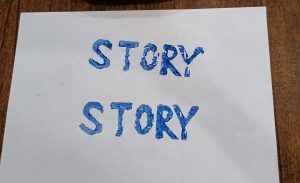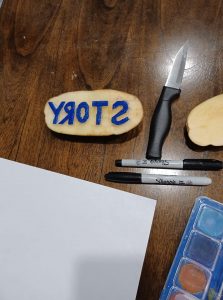I must admit:
I thought, “How difficult could this activity be”?
I imagined revisiting this childhood activity, potato printing, will be real fun.
I envisioned this as an amazing way to spend a Saturday evening.
I was wrong!
Amount of time taken after the grocery trip: 2 hours
In all honesty, the whole process of selecting potato, carving mirror letters, painting, and printing was too laborious; it was painstaking. I spent a good amount of time in the grocery store selecting the right size of potato to fit in all the letters for the chosen word- STORY. I have no idea why it did not cross my mind that I can have the letters carved on several small potatoes instead of all five letters on a large one.
When I first started with the letter S, I could not figure out how to make it backwards. I also tried tracing the letters with a fine tip sharpie on the “wet” potato- Only after rewatching the video, I realized the potato should be dried with a paper towel before writing on it. After switching between a fine tip sharpie, an ultra fine tip sharpie, a pen and pencil, I resorted to using a pencil to carve the letters in. Next, was the carving process. Not one who is born with a knack of patience, not one who have learnt to do better at being patient, and add a healing sprained wrist to the list, I must say that cutting out shapes of the letters with a pairing knife presents a set of real challenge.

Letters S, O and R were more difficult to produce compared to letters T and Y. To print, I chose a dark blue poster paint and worked through a few attempts in determining the right amount of paint needed to print the clear letter I was aiming for. Printing the second time was indeed much more stressful than the first. I strived to brush the same amount of paint on every letter and exert the same amount of pressure on every part of the potato when stamping.
One thing that struck me was that if a mistake was made, there was no way I could backspace and edit.
Photo by Bernard Hermant on Unsplash
Potato printing transported me back to the good old 20+ years ago when I was much much younger, sitting in my mom’s office “typing” away on the typewriter. If a typo was made on the manual typewriter, we had to either “x” through the mistake while adding some creative touches, use the correction fluid or resort to the old-school correction tabs. Unless one is able to type accurately making minimal errors, chances are the final typed document is far from perfect which is in contrast with what Bolter (2001) puts forward in terms of the popular interest in printing press being “simple and clean” (p. 67).
Note. Stencil Rulers, picture taken on October 3, 2021.
I am also reminded of the time when I wanted to avoid using a typewriter and yet maintain the standardized word sizes for my school projects- I used stencil rulers. Though it was easier to line the words in a straight line, mistakes were difficult to fix and if when my brush was overloaded with paint, it either seeped underneath or the ink smudged. Then, to my horror, I had to redo on a fresh piece of paper.
NOW, to spend two hours on printing only one word (STORY) is really too time-consuming. We have definitely come a long way from the early days of mechanizing writing. In Bolter’s (2001) words, “One medium sets out to remediate another, it does so by claiming to do a better job” (p. 26).
The computer, for instance, has become more affordable with the dramatic change in the price of computers over the years. Computer has made my writing life easier. I cannot imagine if I had to write through woodblock or potato printing. Mechanization of writing has made it easier for human race to propel forward.
I will never look at the computer the same way again.
Reference
Bolter, J. D. (2001). Writing space: Computers, hypertext, and the remediation of print [2nd edition]. Mahwah, NJ: Lawrence Erlbaum.
Image Credits
Typewriter – Photo by on Unsplash
